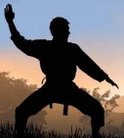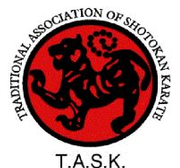
Newport Pagnell
Karate Club

Some useful basic terminology for training in karate.
General Terms: |
|
Japanese | English |
Dojo | Training Hall |
Karate | Empty hand / Chinese hand |
Hidari | Left |
Gi | Training suit |
Kiai | Expression of spirit |
Kime | Focus of power |
Mawate | Turn |
Migi | Right |
Moroto | Double |
Obi | Belt |
Rei | Bow |
Shomen | Front |
Shomen ni rei | Bow to the front |
Shoto | Pine waves |
Shotokan | Hall of pinewaves |
Stances: |
|
Japanese | English |
Dachi | Stance |
Hangetsu Dachi | Half moon stance |
Heiko Dachi | Parallel stance |
Heisoku Dachi | Informal attention stance (feet together) |
Kiba Dachi | Horse riding stance |
Kokusto Dachi | Back stance |
Musubi Dachi | Knot stance |
Neko Ashi Dachi | Cat stance |
Renoji Dachi | L stance |
Shiko Dachi | Square stance |
Shizentai | Natural stance |
Tsuruashi Dachi | Crane stance |
Uchi Hachiji Dachi | Inverted open leg stance |
Zenkutsu Dachi | Front stance |
Blocks: |
|
Japanese | English |
Age Uke | Upper rising block |
Ashibo Kake Uke | Leg hooking block |
Gedan Barai | Downward block / sweep |
Haishu Uke | Backhand block |
Juji Uke | Cross / x block |
Kake Uke | Hooking block |
Kakiwake Uke | Bent wrist block |
Moroto Uke | Double / augmented forearm block |
Manji Uke | Swastika block / High low block / Chinese block |
Nagashi Uke | Sweeping block |
Shuto Uke | Knife hand block |
Soto Ude Uke | Outside forearm block |
Sukui Uke | Scooping block |
Tekubi Kake Uke | Wrist hooking block |
Te Osae Uke | Hand pressing block |
Tsukami Uke | Grasping block |
Uchi Ude Uke | Inside forearm block |
Punches: |
|
Japanese | English |
Age Zuki | Rising punch |
Awase Zuki | U punch |
Choku Zuki | Straight punch |
Gyaku Zuki | Reverse punch |
Heiko Zuki | Parallel punch |
Kagi Zuki | Hook punch |
Kizami Zuki | Jab punch |
Oi Zuki | Stepping punch |
Sanbon Zuki | Three punches |
Tate Zuki | Vertical fist punch |
Ura Zuki | Close punch |
Yama Zuki | Mountain / Wide U Punch |
Strikes: |
|
Japanese | English |
Empi Uchi | Elbow strike |
Hashu Uchi | Backhand strike |
Haito Uchi | Ridge hand strike |
Hiji Ate | Elbow strike |
Nakadaka Ippon Ken | Middle finger one knuckle fist |
Nihon Nukite | Two finger spearhand |
Nukite | Spearhand |
Otoshi Empi Uchi | Downward / dropping elbow strike |
Shuto Uchi | Knifehand strike |
Uraken Uchi | Backfist strike |
Kicks: |
|
Japanese | English |
Fumikiri | Cutting kick |
Fumikomi | Stamping kick |
Geri | Kick |
Kekomi | Thrust kick |
Mae Geri Keage | Front snap kick |
Mae Geri Kekomi | Front thrust kick |
Mae Tobi Geri | Front jumping kick |
Mawashi Geri | Roundhouse kick |
Mikazuki Geri | Crescent kick |
Ushiro Geri | Back kick |
Yoko Geri Keage | Side snap kick |
Yoko Geri Kekomi | Side thrust kick |
Parts of the body: |
|
Japanese | English |
Ago | Chin |
Ashi | Foot or leg |
Ashiko | Instep |
Ashikubi | Ankle |
Chichi | Nipple |
Chudan | Chest / middle level |
Chusoku | Ball of foot |
Do | Torso / trunk of the body |
Empi | Elbow |
Ensho | Round heel |
Gaiwan | Outer arm |
Gedan | Groin / lower level |
Gawa | Side |
Goshi | Hip |
Haibu | Back area |
Haishu | Back of hand |
Haisoku | Instep |
Haito | Ridge hand |
Haiwan | Back arm |
Hana | Nose |
Hiji | Elbow |
Hiraken | Flat / fore knuckle fist |
Hiza | Knee / lap |
Ippon Ken | One knuckle fist |
Kaisho | Open hand |
Kakato | Heel |
Kakuto | Bent wrist |
Kanjinoke | Hair |
Kau | Face |
Keito | Chicken hand wrist |
Kentsui | Hammer fist |
Koko | Tiger mouth |
Koshi | Ball of foot / hips |
Kote | Wrist |
Kubi | Neck |
Kuchi | Mouth |
Kumade | Bear hand |
Me | Eyes (pronounced may) |
Mune | Chest / abdomen |
Naiwan | Inner arm |
Seika Tanden | Lower abdobmen |
Seiken | Forefist |
Seiryuto | Ox jaw hand |
Shita | Tongue |
Shuwan | Palm arm |
Sokuto | Edge of foot |
Tanden | Lower abdomen |
Te | Hand |
Teisho | Palm heel |
Tobu | Head area except face |
Tsumasaki | Tip of toes |
Ubi | Fingers |
Wan | Arm |
Washide | Eagle hand |
Oss
This is a curious term which is heard often throughout all Karate Lessons. It can mean a multitude of different things. It can be used as a greeting when bowing to other karateka, it can be used to indicate to other karateka that you are ready, it can be used to the instructor to indicate that you have understood an instruction. It can be used as a mark of respect when bowing to higher grades and it can also be used as a respectful way of saying to the Instructor I understand but please be patient whilst I try to put what you have taught me into practice.
Oss derives from two Chinese characters one means to bear hardship the other to push aside obstacles.

